
What began as a peaceful uprising against Syria's President Bashar al-Assad five years ago became a full-scale civil war that has left more than 250,000 people dead, devastated the country and drawn in global powers.
Why is there a war in Syria?
Long before the conflict began, most Syrians complained about high unemployment, widespread corruption, a lack of political freedom, and state repression under President Bashar al-Assad, who succeeded his father, Hafez, in 2000.
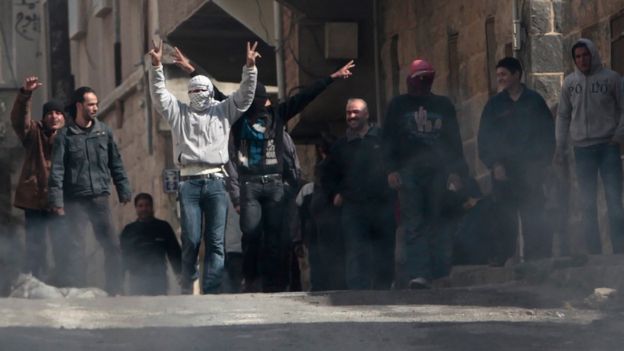
Protests in the southern city of Deraa in March 2011 were suppressed by security forces
In March 2011, pro-democracy demonstrations inspired by the Arab Spring erupted in the southern city of Deraa. The government's use of deadly force to crush the dissent soon triggered nationwide protests demanding the president's resignation.
As the unrest spread, the crackdown intensified. Opposition supporters began to take up arms, first to defend themselves and later to expel security forces from their local areas. Mr Assad vowed to crush "foreign-backed terrorism" and restore state control.
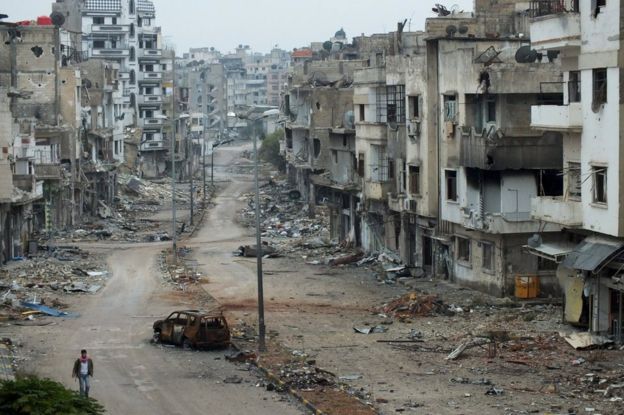
The city of Homs, dubbed "the capital of the revolution" suffered widespread destruction
The violence rapidly escalated and the country descended into civil war as hundreds of rebel brigades were formed to battle government forces for control of the country.
Why has the war lasted so long?

Government forces have lost control of large swathes of the country to various armed groups
In essence, it has become more than just a battle between those for or against Mr Assad. A key factor has been the intervention of regional and world powers, including Iran, Russia, Saudi Arabia and the United States. Their military, financial and political support for the government and opposition has contributed directly to the intensification and continuation of the fighting, and turned Syria into a proxy battleground...A battleground where powerful countries are pushing and shoving each other, in the name of aiding either side in the Syrian civil war.
External powers have also been accused of fostering sectarianism in what was a broadly secular state, pitching the country's Sunni majority against the president's Shia Alawite sect. Such divisions have encouraged both sides to commit atrocities that have not only caused loss of life but also torn apart communities, hardened positions and dimmed hopes for a political settlement.
Jihadist groups have used theses divisions to further their own interests and add a further dimension to the war. So-called Islamic State (IS), which controls large parts of northern and eastern Syria, is battling government forces, rebel brigades and Kurdish groups on the ground, as well as facing air strikes by Russia and a US-led multinational coalition.
Why are so many outside powers involved?
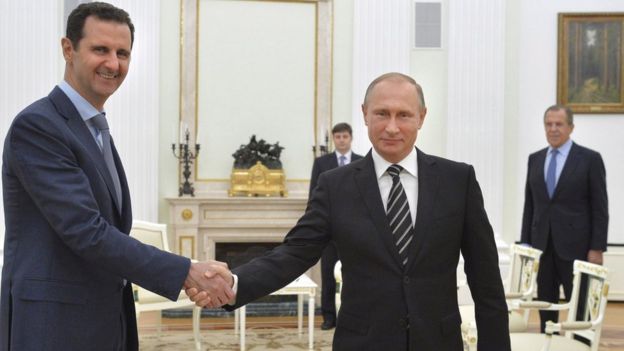
Russia's air campaign aimed to "stabilize" the government of President Bashar al-Assad
Russia, for whom President Assad's survival is critical to maintaining its interests in Syria, launched an air campaign in September 2015 with the aim of "stabilizing" the government after a series of defeats. Moscow stressed that it would target only "terrorists", but activists and citizens insist its strikes mainly hit Western-backed rebel groups.
Six months later, having turned the tide of the war in his ally's favour, President Vladimir Putin ordered the "main part" of Russia's forces to withdraw, saying their mission had "on the whole" been accomplished.
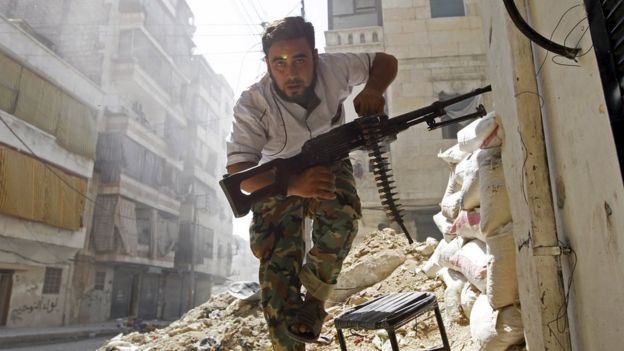
Rebels have received only limited military assistance from Western powers opposed to Mr Assad
Shia power Iran is believed to be spending billions of dollars a year to bolster the Alawite-dominated government, providing military advisers and subsidised weapons, as well as lines of credit and oil transfers. It is also widely reported to have deployed hundreds of combat troops in Syria.
Mr Assad is Iran's closest Arab ally and Syria is the main transit point for Iranian weapons shipments to the Lebanese Shia Islamist movement Hezbollah, which has sent thousands of fighters to support government forces.
The US, which says President Assad is responsible for widespread atrocities and must step down, has provided only limited military assistance to "moderate" rebels, fearful that advanced weapons might end up in the hands of jihadists. Since September 2014, the US has conducted air strikes on IS in Syria, but it has avoided attacking government forces.
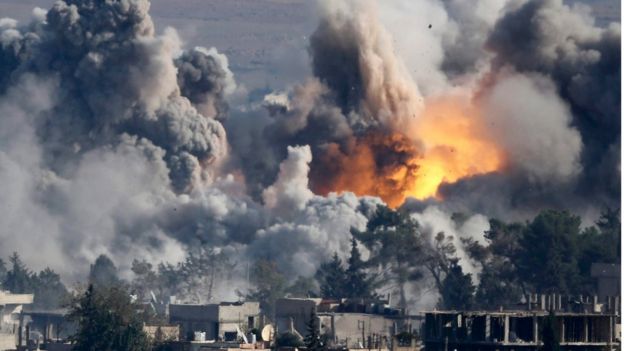
A US-led coalition has been conducting air strikes on Islamic State militants in Syria since 2014
Sunni-ruled Saudi Arabia, which is seeking to counter the influence of its rival Iran, has been a major provider of military and financial assistance to the rebels, including those with Islamist ideologies.
Turkey, another staunch supporter of the rebels, has meanwhile sought to limit US support for Kurdish forces battling IS militants in northern Syria, accusing them of being affiliated to the banned Turkish Kurdistan Workers' Party (PKK).
What impact has the war had?
Turkey, another staunch supporter of the rebels, has meanwhile sought to limit US support for Kurdish forces battling IS militants in northern Syria, accusing them of being affiliated to the banned Turkish Kurdistan Workers' Party (PKK).
What impact has the war had?
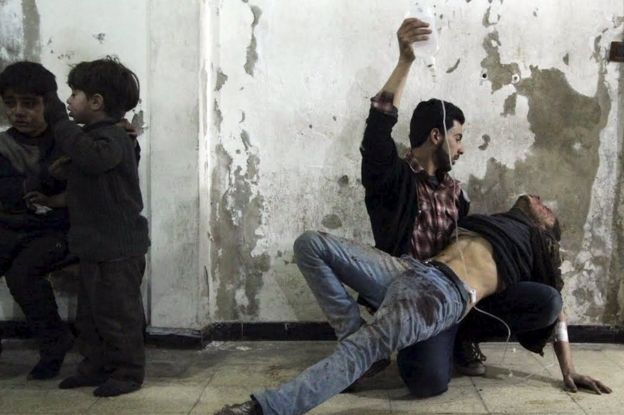
There are no reliably accurate statistics on the number of people killed or wounded in the fighting
The UN says over 250,000 people have been killed in the past five years. However, the organization stopped updating its figures in August 2015. Monitoring groups put the death toll at 270,000, while a think-tank recently estimated that the conflict had caused 470,000 deaths, either directly or indirectly.
More than 4.8 million people have fled Syria, most of them women and children. Neighbouring Lebanon, Jordan and Turkey have struggled to cope with one of the largest refugee exoduses in recent history.
About 10% of Syrian refugees have sought safety in Europe, sowing political divisions as countries argue over sharing the burden. A further 6.5 million people are internally displaced inside Syria.
More than 4.8 million people have fled Syria, most of them women and children. Neighbouring Lebanon, Jordan and Turkey have struggled to cope with one of the largest refugee exoduses in recent history.
About 10% of Syrian refugees have sought safety in Europe, sowing political divisions as countries argue over sharing the burden. A further 6.5 million people are internally displaced inside Syria.
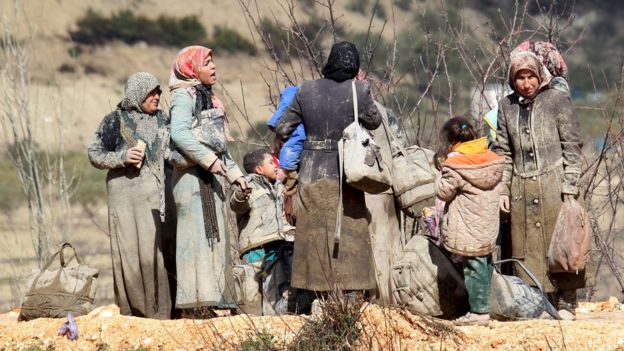
Almost half of Syria's pre-war population of 23 million has been displaced by the war
The UN says it will need $3.2bn to help the 13.5 million people, including six million children, who will require some form of humanitarian assistance inside Syria in 2016. About 70% of the population is without access to adequate drinking water, one-in-three people are unable to meet their basic food needs, more than two million children are out of school, and four out of five people live in poverty.
The warring parties have compounded the problems by refusing humanitarian agencies access to many of those in need. Some 4.6 million people live in hard-to-reach areas, including almost 500,000 people in besieged locations.
The warring parties have compounded the problems by refusing humanitarian agencies access to many of those in need. Some 4.6 million people live in hard-to-reach areas, including almost 500,000 people in besieged locations.
France and the UK have called on the UN to begin air drops of humanitarian aid to besieged areas in Syria. Last month, the International Syria Support Group (ISSG) set a deadline of 1 June for the distribution of urgent humanitarian supplies. But only a small amount of aid was delivered on Wednesday and a convoy to the town of Darayya near Damascus did not even carry food. The UN Security Council will meet on Friday to discuss the air drops.
What's being done to end the fighting?
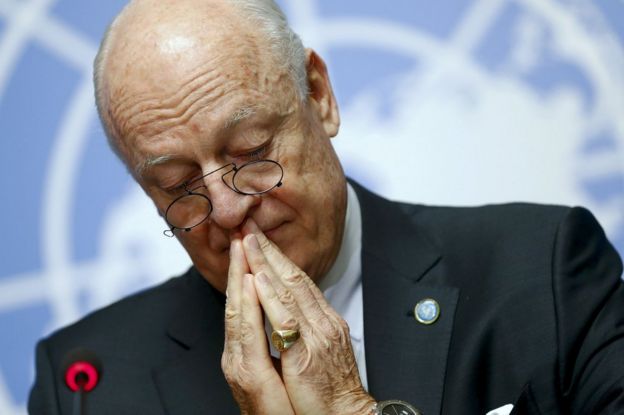
All previous attempts by the UN to broker a political settlement have failed
With neither side able to inflict a decisive defeat on the other, the international community long ago concluded that only a political solution could end the conflict. The UN Security Council has called for the implementation of the 2012 Geneva Communique, which envisages a transitional governing body with full executive powers "formed on the basis of mutual consent".
Peace talks in early 2014, known as Geneva II, broke down after only two rounds, with the UN blaming the Syrian government's refusal to discuss opposition demands.
A year later, the conflict with IS lent fresh impetus to the search for a political solution in Syria. The US and Russia persuaded representatives of the warring parties to attend "proximity talks" in Geneva in January 2016 to discuss a Security Council-endorsed road map for peace, including a ceasefire and a transitional period ending with elections.
Peace talks in early 2014, known as Geneva II, broke down after only two rounds, with the UN blaming the Syrian government's refusal to discuss opposition demands.
A year later, the conflict with IS lent fresh impetus to the search for a political solution in Syria. The US and Russia persuaded representatives of the warring parties to attend "proximity talks" in Geneva in January 2016 to discuss a Security Council-endorsed road map for peace, including a ceasefire and a transitional period ending with elections.
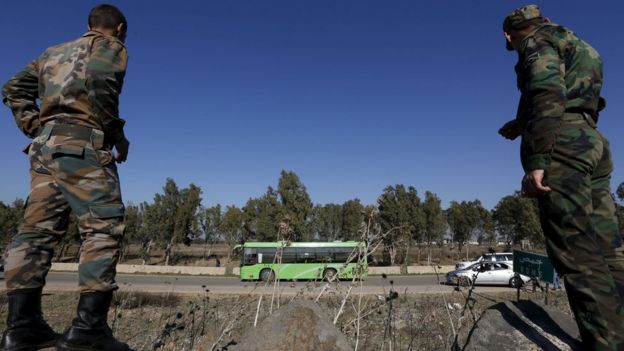
A local truce in the Homs suburb of al-Wair in December allowed rebel fighters to be evacuated
The first round broke down while still in the "preparatory" phase, as government forces launched a major offensive to around the northern city of Aleppo. But the talks resumed in March 2016, two weeks after after the US and Russia brokered a nationwide, but partial, "cessation of hostilities" that Washington said saw the level of violence fall by up to 90%. The slowdown in the fighting is temporary. As always, the fighting will begin again. There is hope that having a common enemy (Islamic State) will eventually unite warring factions to fight IS (or ISIS) together. But the first order of business is to get Mr Assad to step down and agree to an interim government.
I was asked to explain the Syrian war, in simple terms, to someone the other day because it has become so confusing and complicated. Fortunately I found very good material on the subject and I hope it has helped.
No comments:
Post a Comment
Through this ever open gate
None come too early
None too late
Thanks for dropping in ... the PICs